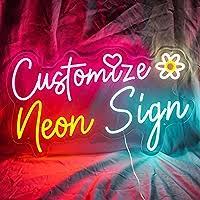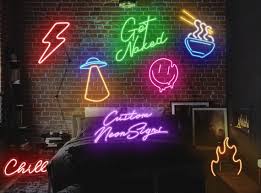Creating custom LED light signs can be a transformative decision for both businesses and individuals looking to enhance their environments with vibrant, eye-catching displays. This answer will explore the essential aspects, considerations, and advantages of custom LED light signs, providing insights that can guide your decisions in this area.
1. Understanding LED Technology
LED (Light Emitting Diode) technology has revolutionized the way we illuminate our spaces. Unlike traditional incandescent bulbs, LEDs are more energy-efficient, have a longer lifespan, and offer greater versatility in terms of color and brightness. This is crucial for custom signage, as the ability to manipulate color and brightness can significantly impact visibility and aesthetics.
Key Points:
- Energy Efficiency: LEDs consume up to 75% less energy than traditional lighting, reducing operational costs.
- Longevity: With a lifespan of over 25,000 hours, LED signs require less frequent replacement.
- Vibrancy: LEDs produce brighter colors, enhancing the overall appearance of the sign.
2. Design Considerations

When designing a custom LED light sign, several factors must be considered:
-
Purpose: What is the primary goal of the sign? Is it for advertising, decoration, or directional purposes? Defining the purpose will guide the design process.
-
Size and Scale: The size of the sign should be proportional to the space where it will be placed. Consider how far away viewers will be and choose dimensions accordingly.
-
Font and Typography: The choice of font plays a significant role in readability and brand identity. Bold, clear fonts are often more effective for outdoor signs, while decorative fonts may suit indoor spaces.
-
Color Scheme: Select colors that align with your brand or the intended atmosphere of the space. High-contrast colors improve visibility, while softer tones can create a calming effect.
-
Graphics and Logos: Including logos or specific graphics can help in brand recognition. Ensure that these elements are simplified for clarity and visibility from a distance.
3. Material Choices
The materials used in the construction of custom LED light signs can influence durability, appearance, and cost. Common materials include:
-
Acrylic: Lightweight and versatile, acrylic is often used for the sign’s face due to its clarity and ability to diffuse light evenly.
-
Aluminum: A durable choice for the backing of the custom LED light signs, aluminum is resistant to rust and can withstand various weather conditions.
-
PVC: Affordable and lightweight, PVC can be used for indoor signs but may not be as durable as acrylic or aluminum for outdoor use.
-
Wood: For a rustic or vintage look, wood can be used, especially for cafes and boutiques, but it may require additional treatment to withstand outdoor conditions.
4. Customization Options
Custom LED signs can be tailored in numerous ways to meet specific needs:
-
Shape: Signs can be cut into various shapes, from standard rectangles to unique custom designs, allowing for greater creativity.
-
Lighting Effects: Some signs incorporate dynamic lighting effects, such as flashing, fading, or color-changing capabilities. These features can attract attention and enhance visual appeal.
-
Control Systems: Advanced signs can include programmable controls, allowing you to change messages or effects remotely. This is particularly useful for businesses that want to update promotions frequently.
5. Installation and Maintenance
Proper installation is crucial to the longevity and effectiveness of custom LED signs. Considerations include:
-
Location: Choose a spot that maximizes visibility. High-traffic areas are ideal for advertising signs.
-
Mounting: Ensure the sign is securely mounted to withstand wind and weather if placed outdoors. Consult professionals for complex installations.
-
Maintenance: LEDs require minimal maintenance, but it’s essential to keep the sign clean and check for any malfunctioning bulbs. Regular inspections can help prevent issues.
6. Applications of Custom LED Signs
Custom LED signs have diverse applications across various sectors:
-
Retail: Stores use LED signs for promotions, opening hours, and directional signage, effectively drawing customers' attention.
-
Restaurants: Menus, specials, and ambiance can be enhanced with custom LED signs, adding a modern touch to the dining experience.
-
Events: For weddings, parties, or corporate events, custom LED light signs can be used for décor, wayfinding, or to showcase themes and branding.
-
Residential: Homeowners can personalize their spaces with LED signs, using them for decoration or as playful expressions of personality.
7. Cost Considerations
The cost of custom LED signs can vary widely based on several factors:
-
Size: Larger signs generally cost more due to increased materials and labor.
-
Complexity: Custom designs with intricate graphics or dynamic lighting effects will typically be more expensive.
-
Installation: Professional installation services can add to the overall cost, but they ensure safety and proper placement.
-
Longevity: While the initial investment may seem high, consider the long-term savings in energy efficiency and durability, which can offset upfront costs over time.
8. Environmental Impact
As businesses and consumers become increasingly aware of environmental issues, it’s important to consider the sustainability of custom LED signs:
-
Energy Consumption: LEDs have a lower carbon footprint compared to traditional lighting methods, contributing to greener practices.
-
Materials: Opt for sustainable materials where possible. Some manufacturers offer eco-friendly options for the construction of signs.
-
Disposal: Consider how to properly dispose of or recycle LED signs at the end of their life cycle to minimize environmental impact.
9. Regulatory Considerations
Depending on your location, there may be regulations governing the use of signage, especially in commercial spaces. Check local laws regarding:
-
Zoning Restrictions: Certain areas may have specific rules about the size, brightness, and types of signs allowed.
-
Permitting: You may need permits for installation, especially for larger signs or those that incorporate electrical elements.
-
Safety Codes: Ensure that your sign adheres to electrical safety codes to prevent hazards.
10. Conclusion: The Value of Custom LED Signs
Investing in custom LED light signs offers numerous benefits, from enhanced visibility and branding to energy savings and longevity. By carefully considering the design, materials, and applications, businesses and individuals can create impactful signage that stands out and communicates effectively. The versatility of LED technology opens up endless possibilities for creativity, allowing for signs that not only serve a functional purpose but also contribute to the overall aesthetic of any space.
Ultimately, custom LED light signs are more than just a means of illumination; they are powerful tools for communication and expression in our modern world.




